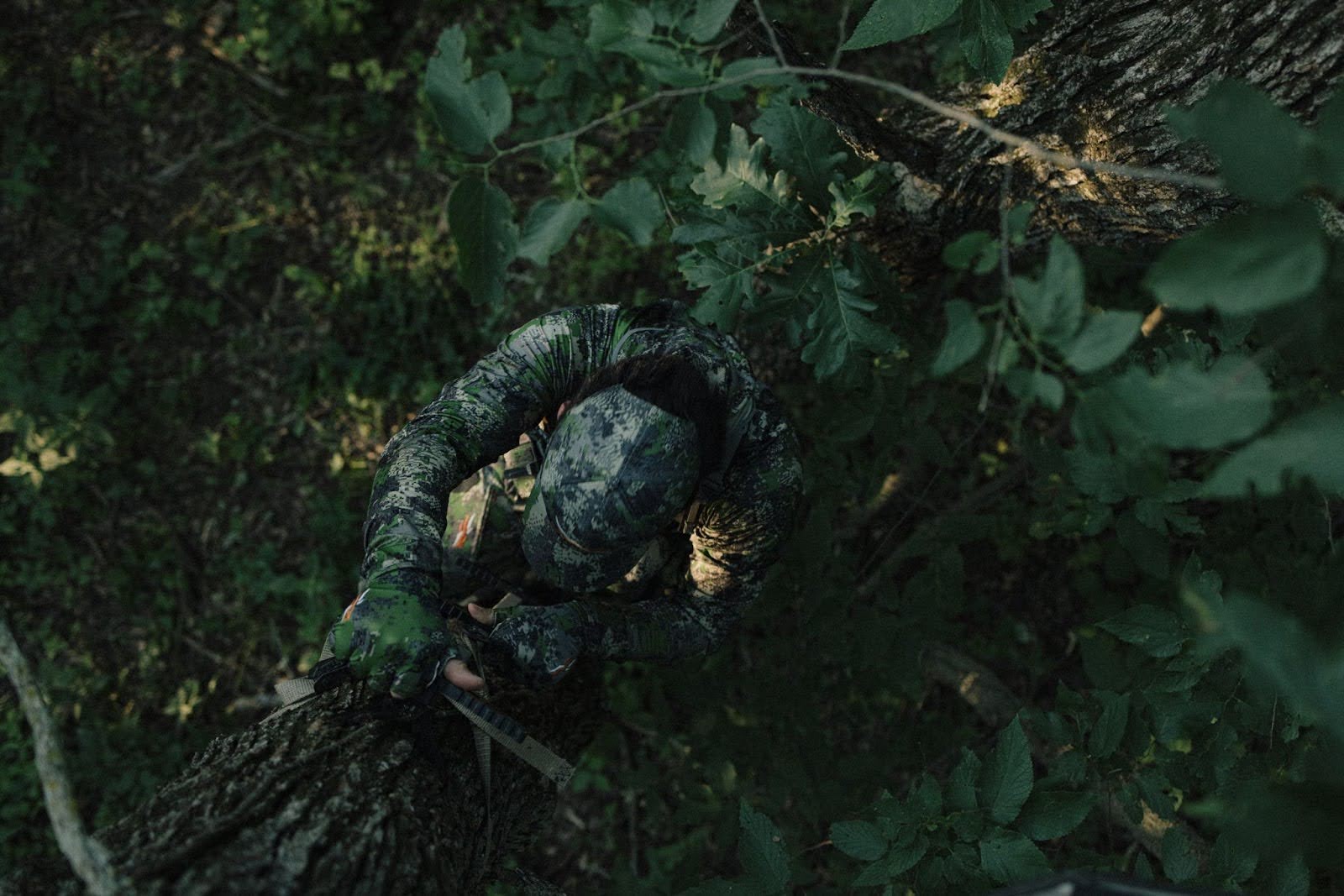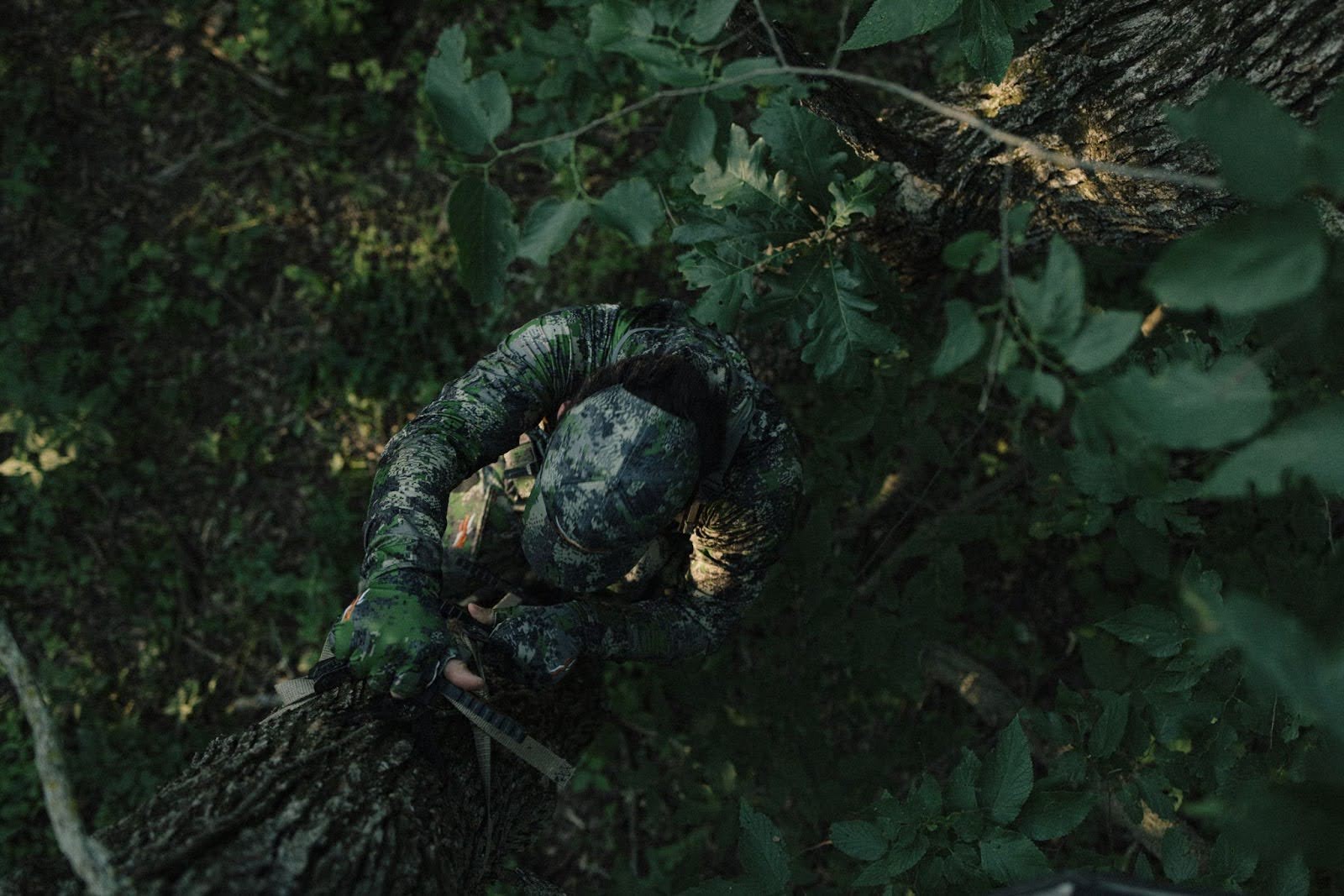Joe Fields | 7.31.2025
Layering for Hunting: How to Layer Hunting Clothes
Layering for Hunting: How to Layer Hunting Clothes
Anyone who’s spent the day damp and shivering in a metal tree stand or squatting in the marsh knows that layering for hunting is a must—no matter your target or time of year.
But if you’re new to the scene, you might not have a clear bead on how to layer hunting clothes. Do you really need base layers? Is a big puffer the only way to tackle late-season whitetail hunts? Even if you’re not new to hunting, getting your layering dialed in is no easy task.
Whether you’re building your first apparel system or looking for an in-depth primer before an expensive excursion, we’ve got you covered. Below, we’ll explain why layering is so important, go into detail on each layer you’ll need in your arsenal, provide tips on getting it right, and more.
Why Layering Matters for Hunting
The right layers can play a huge part in leveling up your hunting experience, whether you’re shooting for waterfowl on a cold, rainy day or hiking through the backcountry searching for a ram. Proper layering will keep your mind on the hunt and provide critical protection from the changing elements.
The Benefits of Proper Layering
Layering has two key benefits for hunters:
Comfort – Exposing yourself to the elements is tricky because you have no control over how the forecast shakes out. When a flash storm rolls through and dumps a couple inches of rain mixed with 50+ mph winds, the only barrier separating you from that brutality is what you're wearing and what's in your pack. You might have nerves of steel, but if you're unprepared for that kind of weather, you will inevitably need to head back home to dry off and warm up.
Adaptability – With the right array of deer hunting gear (or a system perfectly suited to any species for that matter), you can change your approach at a moment’s notice. Want to ditch your ground blind (and your protection from the wind) for a tree stand at the last minute? If you’re already donning a windbreaker or have it stowed close by, there’s no need to hustle back to camp before the light runs out.
Plus, with the right configuration, you can skip your old-school, noisy parka for a layering system that will keep you warm without the bulk (and the dreaded swishing of fabric as you try to line up a shot).
The Science Behind Layering
Staying warm during hunting really is about science—specifically, physics. With a good layering system, you can:
Retain body heat – Your performance hunting system isn’t complete without next-to-skin baselayers. They work to trap excess body heat and keep it close. The more room between your body and your first layer, the more uneven the layer of warm air will be, resulting in cold spots in places where the heat has space to dissipate.
Manage moisture – While that jacket and t-shirt combo might feel great at camp, you’re bound to get warmer on your walk to the stand—or during your glassing route. Once you start sweating, you need a layer to absorb and wick away the moisture accumulating on your skin (moisture that will only make you cold if not properly wicked away).
Protect against the elements – Whether the forecast is calling for rain or you have to endure a splashy boat ride to your favorite bufflehead honey hole, your layers need to keep you warm and dry. Baselayers, along with moisture management of their own, will add more protection from a leaky rain coat or inadequately baffled down jacket. Without a base layer, the elements will have a direct line to your body once they get past your outermost layer.
The Essential Layers for Hunting Clothes
With the above in mind, let’s jump into the essential layers for hunting.
Baselayer – The Foundation
Your dad might have called them "long johns" years back, but we've come a long way since the days of chunky waffle knit sets. Baselayers are shirts and pants that sit next to the body and play the important role of keeping your body’s heat locked in and excess moisture from sweat pulled away from your skin.
Base layers are typically made from a few different types of materials:
Merino or other wools – Merino is becoming more popular in the hunting world; it’s naturally temperature-regulating, wicks moisture, and is odor-resistant. Our Core Merino 330 Half-Zip is a textbook example. Traditional wools work well, but they’re bulkier than merino and have a tendency to itch in certain conditions. Check out our full collection of merino wool hunting clothes. Bonus: merino is almost always machine washable.
Synthetics – Polyester, nylon, and other synthetic materials can also help you keep heat in. But a healthy synthetic blend can also make your base layers more comfortable, stretchy, and durable—like SITKA’s Heavyweight Bottom layer.
Cotton – Easily available nearly anywhere you shop, cotton has been a long-time staple, though it has its drawbacks. We recommend not relying on cotton in the winter, if you can help it. Once it gets wet, whether from sweat or the elements, it loses all warmth and takes forever to dry.
Insulating Layer – Retaining Heat
While your baselayers help you keep heat close, your insulating layers are there to help you retain that heat. If you wore nothing but your base layers to the dove field, you might stay warm for a few minutes—but you need something more substantial to help you keep that heat in.
Typical insulation materials include down, fleece, and synthetic blends; all of which are available in different weights. When choosing your insulating layer, try to balance a few factors:
Packability – It should be somewhat easy to roll your quarter-zip or hunting hoodie into your backpack or tie it around your waist.
Fabric Thickness – While your base layers should be thinner, you can look for somewhat thicker garments for your mid layer. If you bulk here, you won’t need a bulky outer shell in many cases (more on this later). SITKA’s HyperDown Jacket offers the perfect balance of bulk and warmth.
Temperature – You want this layer to keep you warm—but not too warm. Try to find a balance between a piece that’s comfortable on your walk (while you’re moving the most) and during your sit (when you’re moving the least).
Outerwear – Weather Protection
Your outerwear is the most important item in your hunting system if you’re out in a wet, windy, or ultra-cold environment—so, just about any duck blind, deer stand, or ridgeline. Your outer shell should at least be windproof, but for hunts with moisture in the forecast, waterproofing is essential.
When it comes to choosing your outerwear, pick a layer that makes the most sense for your system.
Thick insulating layer – If you’re packing on the puff over top of your base layers, you may not need a super thick shell. You might be able to get away with a bulky insulating layer under a simple raincoat, like SITKA’s Thunderhead Jacket.
Heavier outer shell – If you’re trying to keep your base and insulating layers relatively thin (and shed your warmest layer as easily as possible), opt for a bulkier outer shell—like our Incinerator Aerolite Jacket.
Accessories to Enhance Your Hunting Layers
Headgear and Gloves
Your packing list isn’t complete without a hat and gloves. These pieces should be lightweight but insulating—especially if you’re battling the cold.
This is particularly true for hunting gloves. While your granddad may have just cut off the trigger fingertip on his favorite pair of wool gloves, today’s technology makes it easy to balance dexterity with warmth.
Weatherproofing matters here, too. If you’re hunting without overhead protection (in a tree stand, for instance), your hat and gloves need to be waterproof if rain is in the forecast. If you’re posted in a box stand, you might be able to reach for mittens until it’s time to take aim.
Socks and Footwear Considerations
While you can certainly chuck some Hot Hands packs into your boots, this isn’t the most comfortable option for stalking or mobile hunts. Instead, consider layering your socks too.
This is where merino really shines: merino socks take out the bulk of old-school wool socks but retain all of the warmth (with moisture-wicking to boot).
And speaking of boots, choose footwear that makes sense for your pursuit. We prefer pull-on boots that are both warm and dry.
Layering Tips for Maximum Efficiency
Adapting to Activity Levels
Your layering situation should vary based on your planned activity level. If you’re planning a long trail hunt or an all-day stalk, consider the “be bold, go cold” philosophy. In other words, keep in mind that you might work up a sweat if you’re moving a lot during your hunt and wearing too many layers could cause you to overheat after just an hour or two of stalking (even if it feels like you’re underdressed when you get out of the truck).
On the other hand, if you’re sitting in a stand or a blind, don’t underestimate how quickly the chill can set in when you’re in the same spot for multiple hours. Whitetail hunters, take note: the stiller you have to be, the colder you’re going to get (without the proper layers, of course).
Packing Smart for Hunting Trips
Of course, if this sounds like too many layers, it just might be. If you’re hitting opening day of dove season in the Southeast, it might not make sense to wear base layers as part of your dove hunting kit. Preventing overheating is just as important as preventing hypothermia.
But even if the forecast is calling for above-average temperatures, pack smart. Throw in that puffer, hunting fleece, or thin base layer just in case the wind changes in the middle of the trip.
Why Choose SITKA for Your Layering System?
We’ve explored why (and how) you should adopt a layering philosophy—it’ll keep you warm, dry, and flexible, no matter your species.
But why choose SITKA? Because our gear works—guaranteed. We stand behind every product we make, and our complete systems transform hunting experiences. Whether you’re prepping for your first backcountry expedition or building the perfect system for early-season duck hunting in the south, SITKA has the gear you need.
Explore our collection of hunting gear and start building the perfect layering system.
Sources
PBS North Carolina. The Science of Staying Warm in Winter.


